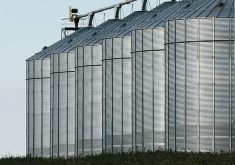SOUTH
Another week of cool, wet weather continues to delay harvest. Many producers are unable to get back in the field. Swaths are slow to dry and most grain is coming off tough.
Cereal and pulse crop quality continues to drop because of bleaching and sprouting.
Strong winds lodged many crops and knocked over bins and rail cars. Combines have been stuck in mud.
An average of 20 percent of the crop has been combined. Another one-third is swathed or ready to straight-cut.
Read Also

Canada and China discuss disputes over canola and EVs, says Ottawa
Senior Canadian and Chinese officials discussed bilateral trade disputes involving canola and electric vehicles on Friday, Ottawa said, but gave no indication of any immediate breakthrough.
Precipitation varied from small amounts to 91 mm in the Moosomin area, which has led the province in accumulation with 874 mm since April 1.
Topsoil moisture conditions are rated 50 percent adequate on cropland and 75 percent adequate on hayland and pastures.
Some winter cereals have been seeded, but the late harvest is closing the window.
CENTRAL
Harvest operations are delayed by cool, wet weather, but several western areas made good progress. Many crops are coming off tough. About 43 percent is swathed or ready for straight-cutting.
Combines and other equipment have been stuck in mud.
There are quality concerns for pulses and cereals that have sprouted and bleached. As well, there is potential for frost damage on crops that are behind normal development. Many crops have lodged.
Precipitation ranged from trace amounts to 94 mm in the Raymore area.
Topsoil moisture conditions are rated 70 percent adequate on cropland and about 75 percent adequate on hayland and pasture.
NORTH
Many areas made little to no harvest progress because of cool temperatures and wet field conditions. Much of the grain has been coming off tough. About 10 percent of the crop is in the bin while about half the crops have been swathed or ready to straight-cut.
Farmers are also hauling bales and moving cattle. Haying continues, but swaths have been slow to dry.
Pulses and cereals are downgrading because of sprouting and bleaching, and there’s potential for frost damage on immature crops.
Rainfall varied from small amounts to 21 mm in the Tisdale area.
Topsoil moisture conditions on cropland, hayland and pastures are rated about 90 percent adequate.














